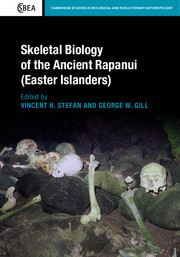Book contents
- Frontmatter
- Contents
- List of contributors
- Acknowledgements
- 1 Introduction: Research overview
- 2 Review of Polynesian and Pacific skeletal biology
- 3 Chronology and Easter Island prehistory
- 4 A descriptive skeletal biology analysis of the ancient Easter Island population
- 5 Craniometric variation of the prehistoric Polynesians and Rapanui
- 6 Rapanui non-metric cranial traits
- 7 Intra-island discrete cranial trait variation
- 8 Continuous non-metric characteristics of the early Rapanui
- 9 Rapanui dental morphology
- 10 Pelvic variability and sexual dimorphism in prehistoric Rapanui
- 11 Genetic affinities of the Rapanui
- 12 Archaeogenetics and paleodemographic estimation of founding populations: Features of residential geography on Rapa Nui
- 13 Evidence for injuries and violent death
- 14 Demographic analysis of modified crania from Rapa Nui
- 15 East Polynesian and Paleoindian parallels and contrasts in skeletal morphology
- 16 Rapanui origins, relationships, and warfare: A summary in theoretical context
- References
- Index
15 - East Polynesian and Paleoindian parallels and contrasts in skeletal morphology
Published online by Cambridge University Press: 05 December 2015
- Frontmatter
- Contents
- List of contributors
- Acknowledgements
- 1 Introduction: Research overview
- 2 Review of Polynesian and Pacific skeletal biology
- 3 Chronology and Easter Island prehistory
- 4 A descriptive skeletal biology analysis of the ancient Easter Island population
- 5 Craniometric variation of the prehistoric Polynesians and Rapanui
- 6 Rapanui non-metric cranial traits
- 7 Intra-island discrete cranial trait variation
- 8 Continuous non-metric characteristics of the early Rapanui
- 9 Rapanui dental morphology
- 10 Pelvic variability and sexual dimorphism in prehistoric Rapanui
- 11 Genetic affinities of the Rapanui
- 12 Archaeogenetics and paleodemographic estimation of founding populations: Features of residential geography on Rapa Nui
- 13 Evidence for injuries and violent death
- 14 Demographic analysis of modified crania from Rapa Nui
- 15 East Polynesian and Paleoindian parallels and contrasts in skeletal morphology
- 16 Rapanui origins, relationships, and warfare: A summary in theoretical context
- References
- Index
Summary
Introduction
The two most dramatic geographical expansions of late prehistoric Homo sapiens have been: 1. the peopling of Polynesia, and 2. the settlement of the Americas. Both population movements emanated from East Asia, but traditionally have been viewed as having consisted of two quite different Eurasian population elements that were, in fact rather distantly related genetically. The ancestral Polynesians, a South Asian coastal people, apparently possessed a pattern of physical characteristics (e.g., large, long skulls, reduced cheekbones, wavy hair, male beards, and light skin) resembling the trait pattern of the original Ainu people of Japan, some modern South and West Asians, and even generalized Europeans. The ancestral Native Americans, on the other hand, have been traditionally viewed as a North Asian people from the frozen steppes of the continental interior. They are assumed to have had a different trait pattern (short, wide skulls, heavy, prominent cheekbones, straight black hair, and heavy jaws and teeth) resembling that of modern North and East Asians and many contemporary Amerindian groups. Recent findings, however, call parts of this simple straightforward scenario into question. The Polynesian part of the equation seems accurate; the early American part perhaps less so.
More than any other contemporary population the people of Easter Island probably provide the best physical approximation of the ancestral Polynesians (i.e., the contact period Rapanui and the few unmixed individuals remaining today; not the majority of highly mixed modern Rapanui). This is because the island of Rapa Nui was throughout prehistory the most remote and therefore the most isolated of any of the Polynesian islands. It simply missed the later waves of population movement from mainland Asia that appear to have affected the population genetics of West Polynesia, Micronesia, and to a lesser extent Central Polynesia. This is not to infer that Easter Island existed for centuries without population change. Genetic drift undoubtedly occurred, and some evidence also points to a prehistoric introduction of a very small amount of Native American genetics. This “small thread” of Amerindian ancestry has been suggested by both DNA evidence (Thorsby et al., 2009; Hagelberg, this volume) and patterns of continuous, non-metric cranial traits (Gill et al., 1997; Gill, this volume). Peter Buck (1938), William Mulloy (1974) and others have also suggested more than one Polynesian settlement voyage to Easter Island.
- Type
- Chapter
- Information
- Skeletal Biology of the Ancient Rapanui (Easter Islanders) , pp. 269 - 285Publisher: Cambridge University PressPrint publication year: 2016



